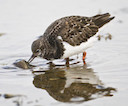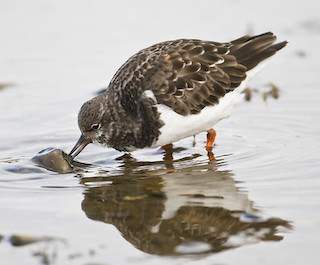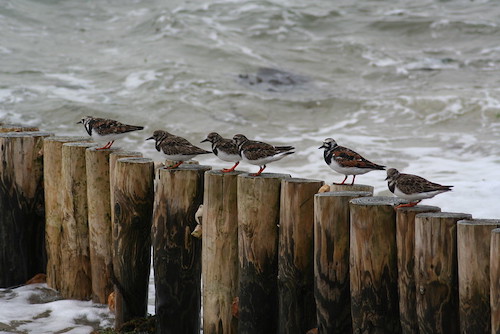 The UK hosts an important overwintering population of Turnstones. Watch out for them on rockier shores round the Lizard coastline.
The UK hosts an important overwintering population of Turnstones. Watch out for them on rockier shores round the Lizard coastline.
Photo: © Natural England/Allan Drewitt
Scientific name: Arenaria interpres
Other common names: Ruddy Turnstone, Flipbrick, Tanglepicker, Sea Dotterel
Conservation status: IUCN Redlist, Least Concern; UK Birds of Conservation Concern, Amber (because of the important overwintering population).
 Even in its drabber winter plumage, you would think that the distinctive orange legs and the strong contrast between the white under parts and darker upper plumage would make a Turnstone fairly easy to spot. Instead, it blends remarkably well into its surroundings as it makes its way over seaweed-covered rocks on the beach, turning over stones as it hunts for food to eat. Its summer breeding plumage is far more distinctive, however, with chequered chestnut-brown and black upper parts, and in flight look for the distinctive white rump and wing bars.
Even in its drabber winter plumage, you would think that the distinctive orange legs and the strong contrast between the white under parts and darker upper plumage would make a Turnstone fairly easy to spot. Instead, it blends remarkably well into its surroundings as it makes its way over seaweed-covered rocks on the beach, turning over stones as it hunts for food to eat. Its summer breeding plumage is far more distinctive, however, with chequered chestnut-brown and black upper parts, and in flight look for the distinctive white rump and wing bars.
This small stocky (c. 22–24 cm length) member of the Sandpiper family (Scolopacidae) can be found all round the UK coastline. Turnstones do not breed in Britain, however (or, at least, only very rarely): their main breeding grounds are in the High Arctic. The species has a circumpolar distribution, but migrates over long distances, overwintering as far south as South Africa and Australia. Here in Britain, numbers increase during the spring and late summer as birds stopover on their way to or from northern Europe, respectively. Birds overwintering here (about 48,000) are generally from Canada and Greenland, arriving in the early autumn and remaining until the spring. In the summer months, non-breeding individuals (generally, birds under two years old) usually remain at the overwintering site rather than travel further north, so can be spotted, though in fewer numbers.

In winter and on migration, Turnstones form large flocks, but pairs are generally solitary when breeding, laying up to four or five eggs in a scrape made on the ground: the eggs are mainly incubated by the female. The young can feed themselves after the first day, but the parents remain to guard them for up to 21 days: the female leaves after a few days, while the male remains until the young fledge.
The Turnstone is a resourceful and opportunistic feeder, eating insects, crustaceans and molluscs, as well as berries, worms, eggs, carrion and even food discarded by humans.
Turnstones on the Helford from Ray Surridge on Vimeo.
Did you know…?
…When hunting for food, the Turnstone can flip stones of close to its own body weight, often using its chest for extra leverage.
…Turnstone plumage shows variations between individuals, helping them identify individuals and distinguish between intruders and birds from adjacent territories.
More information and references:
Gooders, J. and Harris, A., 1986. Field Guide to the Birds of Britain and Ireland. Kingfisher Books, London.
Published: December 2013
Author: Amanda Scott
Photos: Upper – © Natural England/Allan Drewitt; lower – © Natural England/Philip Ray; video – Ray Surridge
